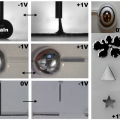Terminator
2 is
widely remembered for its
metal shape-shifting
villain.
Impervious
to
bullets, explosives,
and fire,
the T-1000
robot was
capable of changing shape at will. Researchers at the
North Carolina State University
have taken a step towards
making science fiction a
reality by developing a technique for controlling the surface tension of liquid
metals using very low voltages. This technology paves the way for shape-reconfigurable
metal
components in
electronic, electromagnetic, and
microfluidic devices.
The
researchers, led by Research Triangle MRSEC investigator Michael Dickey, used a
liquid metal alloy of gallium and indium, which forms a spherical shape due to
its large surface tension. By applying a small voltage (
a basic solution, an oxide forms on the surface of the metal, dramatically
lowering the surface tension. This change allows the liquid metal to spread
out, adopt new shapes, and flow in and out of capillary tubes. Reversing the
voltage removes the oxide and returns the metal to its original spherical
shape. These phenomena can be utilized to control the movement and shape of
liquid metal for applications such as microelectromechamical
switches, microactuators,
tunable antennas, and field-programmable circuits.
